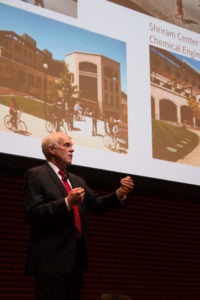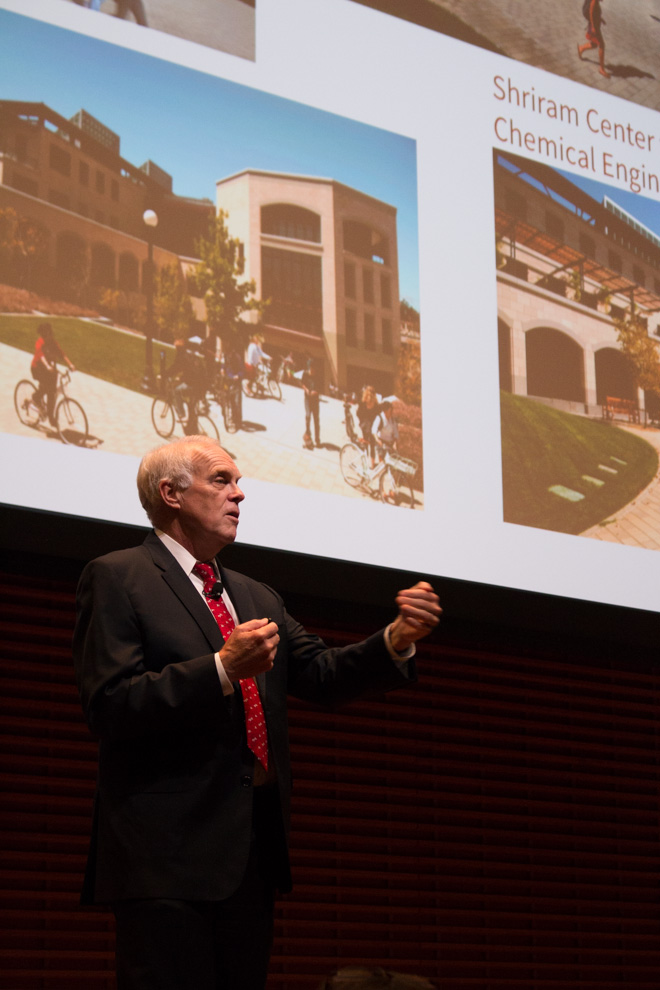
Stanford President John Hennessy gave his farewell address to Academic Council on Thursday afternoon, describing what the University has accomplished during the past 16 years under his tenure. More specifically, Hennessy focused on Stanford’s expansion of financial aid, transformation of on-campus facilities and future initiatives to which he is looking forward.
Although Academic Council meetings usually focus on what the University and Faculty Senate have accomplished during the past year, Thursday’s meeting mainly focused upon Hennessy’s upcoming departure from presidency at the end of this academic year.
Expanding Financial Aid
Hennessy started his presentation by touting Stanford’s success in expanding its financial aid program. He argued that providing monetary aid so that the best students could come to Stanford, regardless of their background, was something that Jane Stanford particularly pushed, citing Stanford’s original tuition of zero dollars.
According to Hennessy, rising tuition was making Stanford prohibitively expensive for many students. Middle-class families were having a harder time paying, while some families would not even consider coming due to the prohibitively high tuition. Hennessy also described “a growing crisis over student debt.”
Stanford expanded its financial aid policy during 2008, right before the Great Recession. This expansion was mostly for undergraduate students, and raised the average financial aid package from $25,000 to $45,000 per year. During the Great Recession, the number of students on financial aid and the size of packages significantly increased, putting a large burden on the University’s strained resources. However, Hennessy was proud to say that this era did not see cuts in financial aid.
Hennessy argued that this expansion has had tangible results. For instance, the number of first-generation college students has increased significantly, and the average amount of student debt has decreased.
However, Hennessy still acknowledged that financial aid has room for improvement. He specifically cited that federal funds for graduate students have been decreasing and argued that the University needs to step in.
Transforming the Campus
Hennessy also discussed the significant physical transformation of campus during his tenure, from creating multidisciplinary spaces to expanding student housing. The President argued that this would have lasting ramifications for student programs and culture.
The first such multidisciplinary space was the Clark Center, which houses faculty from 12 different departments.
“We didn’t know how [the experiment with the Clark Center] would work,” Hennessy said. However, the center has generally been well-received.
According to Hennessy, the building of new University learning complexes, like the Knight Management Center for the Graduate School of Business and the Neukom Building for the Law School, has transformed teaching. For instance, the large number of smaller classrooms in the Knight Management Center has allowed for the newer, more personal teaching style with more collaboration among students and faculty.
Hennessy also argued that the physical transformation of the arts centers have invigorated Stanford’s art program. Hennessy specifically cited the Bing Concert Hall and the McMurtry Building for the department of art and art history.
Along with these transformations, Hennessy also mentioned that he pushed for the plan of Frederick Olmstead, Stanford’s original planner, to be reimplemented. The plan featured four quads, reaching out from the Main Quad. When buildings were replaced, Hennessy pushed for the new buildings to be built in manners that conformed to Olmstead’s idea of the four quads with architectural unity. According to Hennessy, the engineering quad beautifully fulfills Olmstead’s plan, and buildings currently under construction will conform to this ideal as well.
There has also been a more recent focus on student housing. This includes the construction of residences in Manzanita Park and Lagunita Court for undergraduates and Munger Graduate Residence. Hennessy argued that these accommodations are crucial, especially due to the rising cost of living.
Hennessy also stated that although the Windhover Contemplative Center is not a residence, it has become a crucial space in which students can de-stress.
Hennessy additionally commented that new athletic spaces can be credited with increased fitness on campus. These facilities include the new football stadium as well as the building of the Arrillaga Outdoor Education and Recreation Center (AOERC).
According to Hennessy, Stanford has also become more sustainable. During Hennessy’s tenure, the Stanford Energy System and Innovations (SESI) center was implemented, which lowered the amount of water used and has Stanford meeting California’s 2030 plan.
Looking Ahead
Wrapping up, Hennessy articulated what he was looking forward to working on after finishing his tenure as President.
He first addressed the future potential for student community service through the Haas Center. Specifically, Hennessy mentioned the new Cardinal Service program, which features programs such as Cardinal Quarter during which students spend an entire quarter working on community-based projects.
“[Cardinal Service] takes community service to the next level,” Hennessy said.
Hennessy also discussed the plans for future additions to campus. These include expansions in the medical school and hospital complexes, as well as new graduate student residences in Escondido Village and the new campus for staff members in Redwood City.
Hennessy then came full circle, ending with a discussion of his hopes for the Knight-Hennessy Scholars program, which he will direct, to help promising graduate students from around the world learn at Stanford.
Contact Christina Pan at [email protected].
